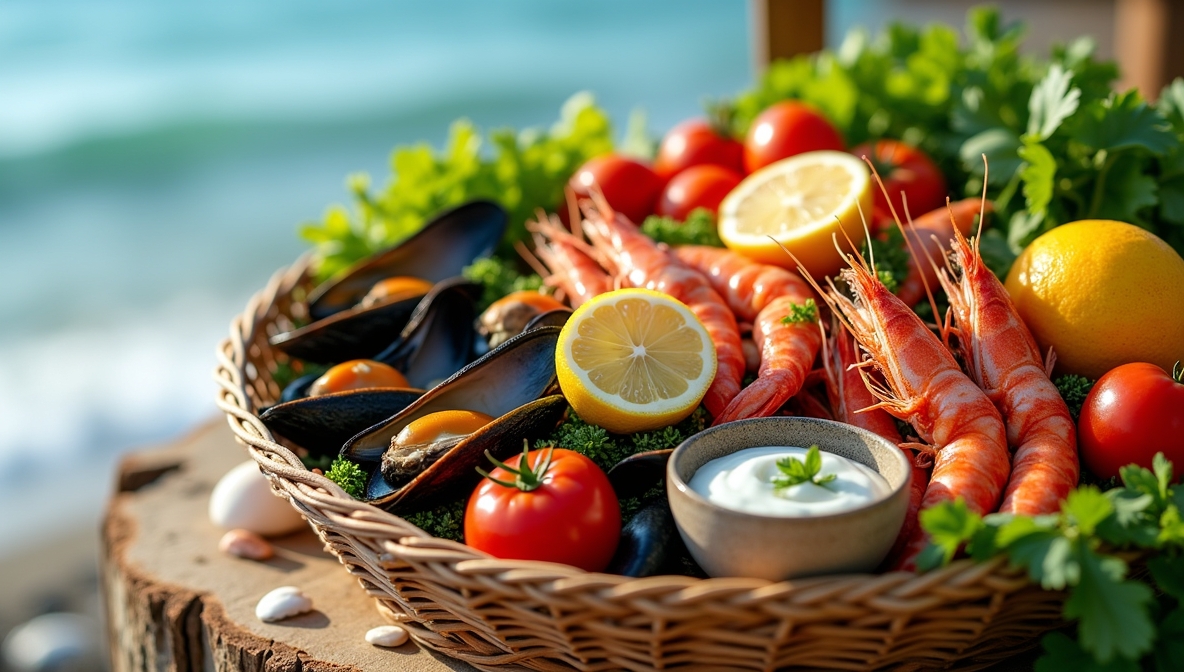Coastal cuisine reflects the rich bounty of local environments, bringing the essence of the sea and surrounding landscapes to the table. The defining ingredients of coastal regions vary across the world, shaped by the availability of seafood, seasonal produce, and cultural traditions. These ingredients not only tell the story of their origins but also contribute to dishes that are both authentic and flavorful.
Seafood Staples
1. Fish Varieties
Local fish such as snapper, mackerel, cod, and grouper are central to many coastal dishes. Their abundance and adaptability make them staples in grilling, frying, and steaming recipes. For example:
- Mediterranean coasts: Sea bass and bream are often grilled with olive oil and herbs.
- Asian shores: Mackerel is commonly used in curries or fermented into pastes.
- Caribbean regions: Snapper is a favorite for ceviche and stews.
2. Shellfish
Crabs, lobsters, clams, mussels, and oysters are harvested fresh from coastal waters. These are enjoyed boiled, baked, or raw, often accompanied by simple seasonings to let their natural flavors shine. Popular examples include:
- New England’s clam chowder
- Spanish paella featuring mussels and clams
- Japanese sashimi-grade oysters
Seaweed and Coastal Greens
3. Seaweed
Edible seaweed varieties such as nori, kelp, and wakame are integral to coastal cuisines worldwide. Rich in umami, they are used in soups, salads, and snacks:
- Japanese miso soup features wakame as a base ingredient.
- Icelandic cuisines incorporate dried seaweed as a nutrient-packed seasoning.
- Coastal France uses seaweed in breads and butters for an oceanic touch.
4. Samphire
Known as sea asparagus, samphire grows along salty coastlines and pairs well with seafood. Its briny flavor adds depth to dishes like grilled fish or seafood salads.
Spices and Aromatics
5. Citrus Fruits
Limes, lemons, and oranges are key in balancing the flavors of coastal dishes. They are used to marinate fish, add zest to salads, or provide acidity in sauces.
- Ceviche relies on lime juice for its signature tang.
- Moroccan seafood tagines use preserved lemons to build depth.
- Tropical drinks like mojitos and mai tais are elevated by fresh citrus.
6. Chilies
Spicy heat often accompanies coastal meals, whether in raw, pickled, or powdered form. Varieties like bird’s eye chilies, habaneros, and jalapeños are staples in:
- Thai seafood curries
- Caribbean jerk marinades
- Mexican seafood tacos
Grains and Legumes
7. Rice
Rice is a neutral base that complements the bold flavors of coastal cooking. In regions such as:
- South India, it serves as the foundation for prawn biryanis.
- Spain, it becomes the centerpiece in iconic paellas.
- West Africa, it pairs with rich fish stews.
8. Beans
Beans such as black-eyed peas, kidney beans, and lentils add protein and texture to meals. These are used in:
- Brazil’s feijoada with salted fish.
- Mediterranean mezze platters with hummus and beans.
- Creole cuisines with red beans and seafood sausages.
Tropical Fruits and Vegetables
9. Coconut
Coconuts provide versatility, with the milk, flesh, and oil used widely in cooking. Coastal dishes such as:
- Thai green curry rely on coconut milk for a creamy texture.
- Malaysian laksa uses coconut oil for its aromatic base.
- Caribbean stews incorporate grated coconut for flavor.
10. Plantains
Plantains, fried or roasted, are common in tropical regions. Their subtle sweetness balances spicy and savory dishes, such as:
- Jamaican escovitch fish with fried plantains.
- West African pepper soup with boiled plantains.
Preserved and Pickled Delights
11. Salted Fish
Salt-preserved fish is a time-honored tradition for preserving seafood in coastal areas. Variations include:
- Italian baccalà used in stews and salads.
- Portuguese bacalhau prepared in hundreds of recipes.
- Scandinavian lutefisk rehydrated and baked.
12. Pickled Vegetables
Pickled cucumbers, radishes, and onions add acidity and crunch. They often accompany rich seafood dishes to cut through the flavors.
Herbs and Flowers
13. Dill
Dill’s light, citrusy notes are favored in:
- Scandinavian cured salmon dishes like gravlax.
- Greek seafood recipes for marinated octopus.
14. Edible Flowers
Flowers such as nasturtiums and hibiscus enhance both flavor and presentation. They are used in salads, teas, and infused syrups.
Regional Examples
Southeast Asia
- Ingredients: Tamarind, lemongrass, kaffir lime leaves.
- Dish: Tom yum soup with shrimp and aromatics.
Mediterranean
- Ingredients: Olive oil, rosemary, capers.
- Dish: Grilled octopus with caper dressing.
Caribbean
- Ingredients: Scotch bonnet chilies, allspice, yams.
- Dish: Spiced fish stew with root vegetables.
Why Local Ingredients Matter
Local ingredients are the foundation of any coastal cuisine, ensuring dishes remain connected to their roots. By using what is naturally abundant, these regions craft meals that reflect the unique ecosystems of their shorelines. Each ingredient contributes not only to the taste but also to the cultural identity of coastal communities.


